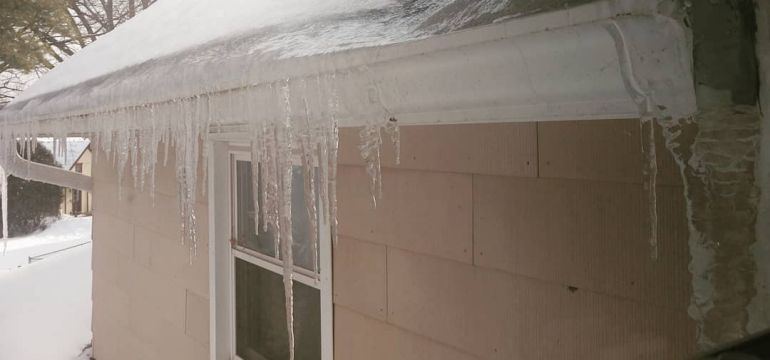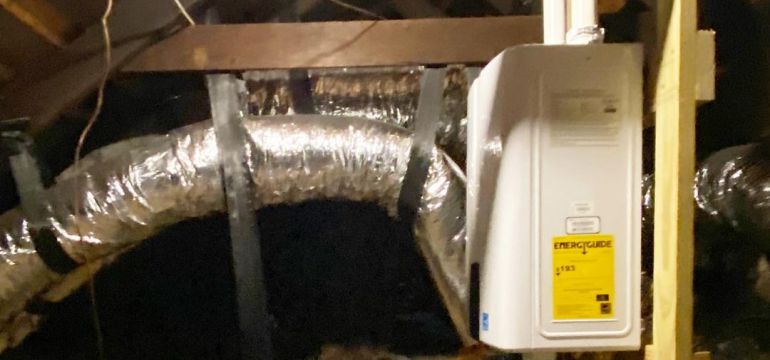Hot water is one of the most frequently used modern luxuries. When you’re building or buying a home, it is important to find out what kind of systems are available for hot water provision and management. Once you know which type of hot water heater you prefer, whether it is tankless, tanked, or some other method, you can decide where to place the unit inside your home.
Typically a hot water heater is located somewhere out of the way, in a less used area of the home. You may be wondering, “Can a tankless water heater be installed in the attic?” What about when the weather is really cold? Will that affect the heater’s function? Discover whether having the hot water heater in the attic is a good or bad idea.
Dangers of a Freezing Attic
 The area inside your attic is insulated, but it isn’t climate-controlled like the rest of your home. So the attic space tends to become very hot during the summer months and very cold during the winter months. If you live in an area of the country where the winters are extremely cold, you may be concerned about the possibility of the hot water heater freezing in the attic, or perhaps you are worried about the pipes freezing as well.
The area inside your attic is insulated, but it isn’t climate-controlled like the rest of your home. So the attic space tends to become very hot during the summer months and very cold during the winter months. If you live in an area of the country where the winters are extremely cold, you may be concerned about the possibility of the hot water heater freezing in the attic, or perhaps you are worried about the pipes freezing as well.
The hot water or the pipes freezing can cause a lot more damage than just a lack of flowing hot water to your bathrooms, kitchen, or laundry room; it can cause burst pipes and flooding, which can result in significant water damage to your home. And water damage is usually time-consuming to repair, as well as potentially expensive.
Protecting Your Electric Water Heater in the Attic
 If you are concerned about having a water heater in the attic during winter, there are ways to work around the problem. Check out these simple things you can do to protect your hot water heater in the attic in freezing weather.
If you are concerned about having a water heater in the attic during winter, there are ways to work around the problem. Check out these simple things you can do to protect your hot water heater in the attic in freezing weather.
☆ Buy an Electric Heater
You can place a small, standard electric heater in the attic to assist with climate control and to keep that zone of your home from reaching sub-zero or freezing temperatures.
However, you will need to take a number of safety precautions. Be sure you have a reliable outlet to plug the heater into, or it will not work. Position it far from any flammable materials. You will need to keep it at a distance from any insulation.
Also, set it on top of a thermal-safe surface, rather than simply placing it on top of the boards of the attic floor. Check on the heater periodically to ensure that it is functioning optimally and not overheating.
☆ Invest in Backup Power
Just being plugged into a power source can help a water heater stay unfrozen. If your area experiences frequent or semi-frequent power outages during the winter, consider investing in a backup power system, such as auto freeze protection (drain-down) solenoids or a standard battery-powered backup.
☆ Add More Insulation
Adding more insulation to the attic itself can help protect your hot water pipes and your hot water heater in the attic from the freezing temperatures outside. If you are concerned that the attic walls and ceiling are not well-insulated, you can DIY a project to add more insulation. It’s a fairly easy task, requiring minimal research.
Also, be sure that the hot water pipes themselves are adequately insulated. If you don’t believe they are insulated well enough, do some thorough research on how to safely beef up the insulation for them, or consult with a local contractor who can do the job for you.
☆ Run the Water
You’ve probably heard of this old trick, and it actually works! When a cold snap is coming, and there’s a risk that pipes could freeze, leave a tiny trickle of water running from the faucets in your home. Moving water doesn’t freeze as readily, so this should help to keep your pipes from freezing.
If you’re concerned about the hot water heater, you can leave a faucet turned to hot, trickling just a bit. Sure, your water bill may be a little higher, but at least you won’t have to worry about other costly repairs from a frozen heater or burst pipes.
If you find that the water heater in your attic isn’t getting your water as hot as usual during the cold months, consider changing the thermostat setting. Adjust it a little higher to compensate for the effects of winter weather. Try bumping it up just 5 or 10 degrees, especially if it’s set to a lower temp like 140 degrees.
Having a hot water heater in the attic isn’t a bad idea, but it may take a little effort on your part to ensure that everything runs smoothly during the colder months of the year.
- Is a Hot Water Heater In the Attic a Good or Bad Idea? - July 18, 2021
- Lawn Mower Starts Then Dies – Here’s the Fix! - June 21, 2021
- Can You Mix Pine-Sol and Bleach? - September 9, 2020
